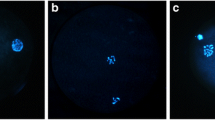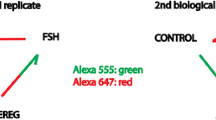Abstract
Purpose
The aim of our study was to determine whether there are any differences in the cumulus cell gene expression profile of mature oocytes derived from modified natural IVF and controlled ovarian hyperstimulation cycles and if these changes could help us understand why modified natural IVF has lower success rates.
Methods
Cumulus cells surrounding mature oocytes that developed to morulae or blastocysts on day 5 after oocyte retrieval were submitted to microarray analysis. The obtained data were then validated using quantitative real-time PCR.
Results
There were 66 differentially expressed genes between cumulus cells of modified natural IVF and controlled ovarian hyperstimulation cycles. Gene ontology analysis revealed the oxidation-reduction process, glutathione metabolic process, xenobiotic metabolic process and gene expression were significantly enriched biological processes in MNIVF cycles. Among differentially expressed genes we observed a large group of small nucleolar RNA’s whose role in folliculogenesis has not yet been established.
Conclusion
The increased expression of genes involved in the oxidation-reduction process probably points to hypoxic conditions in modified natural IVF cycles. This finding opens up new perspectives for the establishment of the potential role that oxidation-reduction processes have in determining success rates of modified natural IVF.


Similar content being viewed by others
References
Steptoe PC, Edwards RG. Birth after the reimplantation of a human embryo. Lancet. 1978;312(8085):366.
Pelinck MJ, Hoek A, Simons AH, Heineman MJ. Efficacy of natural cycle IVF: a review of the literature. Hum Reprod Update. 2002;8:129–39.
Stanford JB, Mikolajczyk RT, Lynch CD, Simonsen SE. Cumulative pregnancy probabilities among couples with subfertility: effects of varying treatments. Fertil Steril. 2010;93:2175–81.
Lintsen AM, Eijkemans MJ, Hunault CC, Bouwmans CA, Hakkaart L, Habbema JD, et al. Predicting ongoing pregnancy chances after IVF and ICSI: a national prospective study. Hum Reprod. 2007;22:2455–62.
Fauser BC, Devroey P, Macklon NS. Multiple birth resulting from ovarian stimulation for subfertility treatment. Lancet. 2005;365:1807–16.
Rizk B, Smitz J. Ovarian hyperstimulation syndrome after superovulation using GnRH agonists for IVF and related procedures. Hum Reprod. 1992;7:320–7.
Nargund G, Frydman R. Towards a more physiological approach to IVF. Reprod Biomed Online. 2007;14:550–2.
Janssens RM, Lambalk CB, Vermeiden JP, Schats R, Schoemaker J. In-vitro fertilization in a spontaneous cycle: easy, cheap and realistic. Hum Reprod. 2000;15:314–8.
de los Santos MJ, García-Láez V, Beltrán-Torregrosa D, Horcajadas JA, Martínez-Conejero JA, Esteban FJ, et al. Hormonal and molecular characterization of follicular fluid, cumulus cells and oocytes from pre-ovulatory follicles in stimulated and unstimulated cycles. Hum Reprod. 2012;27:1596–605.
Claman P, Domingo M, Garner P, Leader A, Spence JE. Natural cycle in vitro fertilization-embryo transfer at the University of Ottawa: an inefficient therapy for tubal infertility. Fertil Steril. 1993;60:298–302.
Lenton EA. Natural cycle IVF with and without terminal HCG: learning from failed cycles. Reprod Biomed Online. 2007;15:149–55.
Paulson RJ, Sauer MV, Francis MM, Macaso TM, Lobo RA. In vitro fertilization in unstimulated cycles: the University of Southern California experience. Fertil Steril. 1992;57:290–3.
Nargund G, Waterstone J, Bland J, Philips Z, Parsons J, Campbell S. Cumulative conception and live birth rates in natural (unstimulated) IVF cycles. Hum Reprod. 2001;16:259–62.
Li Q, McKenzie LJ, Matzuk MM. Revisiting oocyte-somatic cell interactions: in search of novel intrafollicular predictors and regulators of oocyte developmental competence. Mol Hum Reprod. 2008;14:673–8.
Buccione R, Schroeder AC, Eppig JJ. Interactions between somatic cells and germ cells throughout mammalian oogenesis. Biol Reprod. 1990;43:543–7.
Matzuk MM, Burns KH, Viveiros MM, Eppig JJ. Intercellular communication in the mammalian ovary:oocytes carry the conversation. Science. 2002;296:2178–80.
Devjak R, Fon Tacer K, Juvan P, Virant Klun I, Rozman D, Vrtačnik Bokal E. Cumulus cells gene expression profiling in terms of oocyte maturity in controlled ovarian hyperstimulation using GnRH agonist or GnRH antagonist. PLoS ONE. 2012;7:e47106.
Assou S, Haouzi D, Mahmoud K, Aouacheria A, Guillemin Y, Pantesco V, et al. A non-invasive test for assessing embryo potential by gene expression profiles of human cumulus cells: a proof of concept study. Mol Hum Reprod. 2008;14:711–9.
McKenzie LJ, Pangas SA, Carson SA, Kovanci E, Cisneros P, Buster JE, et al. Human cumulus granulosa cell gene expression: a predictor of fertilization and embryo selection in women undergoing IVF. Hum Reprod. 2004;19:2869–74.
Ziebe S, Bangsbøll S, Schmidt KL, Loft A, Lindhard A, Nyboe AA. Embryo quality in natural versus stimulated IVF cycles. Hum Reprod. 2004;19:1457–60.
Ng EH, Lau EY, Yeung WS, Ho PC. Oocyte and embryo quality in patients with excessive ovarian response during in vitro fertilization treatment. J Assist Reprod Genet. 2003;20:186–91.
Grondahl ML, Borup R, Lee YB, Myrhoj V, Meinertz H, Sørensen S. Differences in gene expression of granulosa cells from women undergoing controlled ovarian hyperstimulation with either recombinant follicle-stimulating hormone or highly purified human menopausal gonadotropin. Fertil Steril. 2009;91:1820–30.
Tomazevic T, Gersak K, Meden-Vrtovec H, Drobnic S, Veble A, Valentinčič B, et al. Clinical parameters to predict the success of in vitro fertilization–embryo transfer in the natural cycle. Assist Reprod. 1999;9:149–56.
Gentleman RC, Carey VJ, Bates DM, Bolstad B, Dettling M. Bioconductor: open software development for computational biology and bioinformatics. Genome Biol. 2004;5:R80.
Benjamini Y, Hochberg Y. Controlling the false discovery rate: A practical and powerful approach to multiple testing. J R Stat Soc B Met. 1995;57:289–300.
Nogales-Cadenas R, Carmona-Saez P, Vazquez M, Vicente C, Yang X, Tirado F, et al. GeneCodis: interpreting gene lists through enrichment analysis and integration of diverse biological information. Nucleic Acids Res. 2009;37:W317–22.
Vandesompele J, De Preter K, Pattyn F, Poppe B, Van Roy N, De Paepe A, Speleman F. Accurate normalization of real-time quantitative RT-PCR data by geometric averaging of multiple internal control genes. Genome Biol 2002;3: RESEARCH0034.
Lim J, Luderer U. Oxidative damage increases and antioxidant gene expression decreases with aging in the mouse ovary. Biol Reprod. 2011;84:775–82.
Tatone C, Carbone MC, Falone S, Aimola P, Giardinelli A, Caserta D, et al. Age-dependent changes in the expression of superoxide dismutases and catalase are associated with ultrastructural modifications in human granulosa cells. Mol Hum Reprod. 2006;12:655–60.
Hamatani T, Falco G, Carter MG, Akutsu H, Stagg CA, Sharov AA, et al. Age-associated alteration of gene expression patterns in mouse oocytes. Hum Mol Genet. 2004;13:2263–78.
Matos L, Stevenson D, Gomes F, Silva-Carvalho JL, Almeida H. Superoxide dismutase expression in human cumulus oophorus cells. Mol Hum Reprod. 2009;15:411–9.
Agarwal A, Gupta S, Sharma R. Oxidative stress and its implications in female infertility - a clinician’s perspective. Reprod Biomed Online. 2005;11:641–50.
Shkolnik K, Tadmor A, Ben-Dor S, Nevo N, Galiani D, Dekel N. Reactive oxygen species are indispensable in ovulation. Proc Natl Acad Sci U S A. 2010;108:1462–7.
Tarin JJ. Potential effects of age-associated oxidative stress on mammalian oocytes/embryos. Mol Hum Reprod. 1996;2:717–24.
Seino T, Saito H, Kaneko T, Takahashi T, Kawachiya S, Kurachi H. Eight-hydroxy-2′-deoxyguanosine in granulosa cells is correlated with the quality of oocytes and embryos in an in vitro fertilization-embryo transfer program. Fertil Steril. 2002;77:1184–90.
Du Plessis SS, Makker K, Desai NR, Agarwal A. Impact of oxidative stress on IVF. Expert Rev Obstet Gynecol. 2008;3:539–54.
Attaran M, Pasqualotto E, Falcone T, Goldberg JM, Miller KF, Agarwal A, et al. The effect of follicular fluid reactive oxygen species on the outcome of in vitro fertilization. Int J Fertil Womens Med. 2000;45:314–20.
Jancar N, Kopitar AN, Ihan A, Virant Klun I, Bokal EV. Effect of apoptosis and reactive oxygen species production in human granulosa cells on oocyte fertilization and blastocyst development. J Assist Reprod Genet. 2007;24:91–7.
Yu BP. Cellular defenses against damage from reactive oxygen species. Physiol Rev. 1994;74:139–62.
van Montfoort AP, Geraedts JP, Dumoulin JC, Stassen AP, Evers JL, Ayoubi TA. Differential gene expression in cumulus cells as a prognostic indicator of embryo viability: a microarray analysis. Mol Hum Reprod. 2008;14:157–68.
Luberda Z. The role of glutathione in mammalian gametes. Reprod Biol. 2005;5:5–17.
Zuelke KA, Jones DP, Perreault SD. Glutathione oxidation is associates with altered microtubule function and disrupted fertilization in mature hamster oocytes. Biol Reprod. 1997;57:1413–20.
Mannervik B, Danielson UH. Glutathione transferases. Structure and catalytic activity. Crit Rev Biochem Mol Biol. 1988;23:283–337.
Rabahi F, Brûlé S, Sirois J, Beckers JF, Silversides DW, Lussier JG. High expression of bovine alpha glutathione S-transferase (GSTA1, GSTA2) subunits is mainly associated with steroidogenically active cells and regulated by gonadotropins in bovine ovarian follicles. Endocrinology. 1999;140:3507–17.
Zelko IN, Mariani TJ, Folz RJ. Superoxide dismutase multigene family: a comparison of the CuZn-SOD (SOD1), Mn-SOD (SOD2), and EC-SOD (SOD3) gene structures, evolution, and expression. Free Radic Biol Med. 2002;33:337–49.
Jančar N, Virant-Klun I, Vrtačnik BE. Serum and follicular endocrine profile is different in modified natural cycles than in cycles stimulated with gonadotropin and gonadotropin-releasing hormone antagonist. Fertil Steril. 2009;92:2069–71.
Richards JS, Russell DL, Ochsner S, Espey LL. Ovulation: New dimensions and new regulators of the inflammatory-like response. Annu Rev Physiol. 2002;64:69–92.
Bratkovič T, Rogelj B. Biology and applications of small nucleolar RNAs. Cell Mol Life Sci. 2011;68:3843–51.
Ro S, Song R, Park C, Zheng H, Sanders KM, Yan W. Cloning and expression profiling of small RNAs expressed in the mouse ovary. RNA. 2007;13:2366–80.
Ata B, Yakin K, Balaban B, Urman B. Embryo implantation rates in natural and stimulated assisted reproduction treatment cycles in poor responders. Reprod Biomed Online. 2008;17:207–12.
Gersak K, Lavrencak J, Us-Krasovec M. DNA ploidy of human granulosa cells from natural and stimulated in vitro fertilization cycles. Fertil Steril. 2000;74:158–61.
MacDougall MJ, Tan SL, Hall V, Balen A, Mason BA, Jacobs HS. Comparison of natural with clomiphene citrate-stimulated cycles in in vitro fertilization: a prospective, randomized trial. Fertil Steril. 1994;61:1052–7.
Kim AM, Vogt S, O’Halloran TV, Woodruff TK. Zinc availability regulates exit from meiosis in maturing mammalian oocytes. Nat Chem Biol. 2010;6:674–81.
Acknowledgements
We thank all of the personnel at the Department of Human Reproduction, Division of Gynaecology, University Medical Center Ljubljana, for their contribution to this study. We would especially like to thank the IVF laboratory staff Mses Lili Bačer Kermavner, Jerneja Kmecl, Brigita Valentinčič Gruden and Jožica Mivšek for their work with the biological material.
Author information
Authors and Affiliations
Corresponding author
Additional information
Capsule: The purpose of our study was to compare cumulus cell gene expression between unstimulated and stimulated IVF cycles to determine whether differences in gene expression could reveal why unstimulated IVF has lower success rates.
Rights and permissions
About this article
Cite this article
Papler, T.B., Bokal, E.V., Tacer, K.F. et al. Differences in cumulus cells gene expression between modified natural and stimulated in vitro fertilization cycles. J Assist Reprod Genet 31, 79–88 (2014). https://doi.org/10.1007/s10815-013-0135-6
Received:
Accepted:
Published:
Issue Date:
DOI: https://doi.org/10.1007/s10815-013-0135-6




